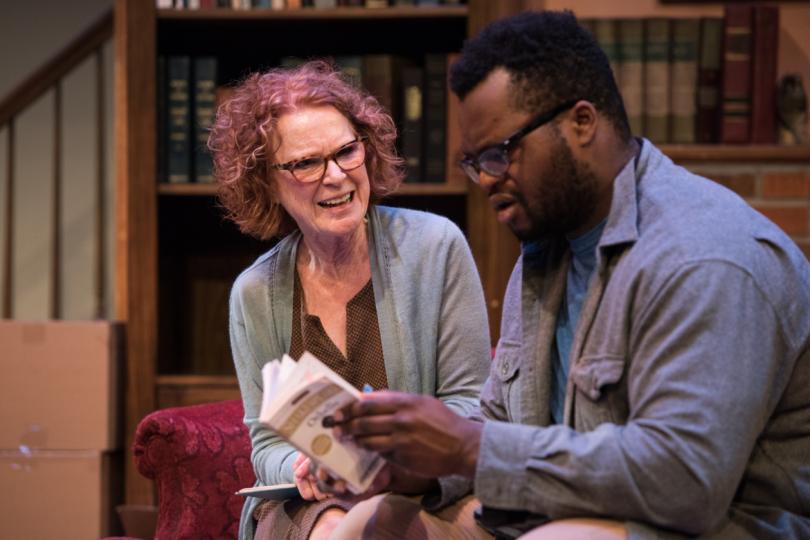Add ¼ cup of Bard

I have a soft spot in my heart for two-person plays. This probably comes from my love of old school speech -- watching high schoolers dressed up in business casual pretending to be witches in front of a white board with their names on it can be a truly meaningful experience. Some of the best two-person speech routines are pulled from two-person plays, as both rely heavily on the acting and chemistry of the actors. Both are either made or broken by the interplay of the actors and their ability to move the action forward together.
I went to the opening night of Taking Shakespeare, so I am willing to say upfront that the show may get better as the run goes on -- cues can be worked on, scene changes can become sharper and faster, and dialogue often gets more refined and naturalistic with each passing night. That being said, my main takeaway is that the script itself, written by John Murrell, does the actors no favors. It simply points towards growth and development without actually showing it, which I would argue is the main point of this type of play. In Gremlin Theatre’s production, Linda Kelsey (Prof) and John A. W. Stephens (Murph) try their hardest to make the haggered Prof and the sweet slacker Murph feel like real human beings interacting. But there is something about how much Taking Shakespeare cleaves to the Bard’s original words that makes the audience deeply aware of how the play they actually paid to watch is rather motivationless and vanilla.
STEREOTYPES
Other reviewers have likened this script to Pygmalion or Educating Rita, and the references are unavoidable. In these other stories, a broken but brilliant man teaches (but also learns from) a woman who is rough around the edges. I am sure Murrell seeks to overturn this narrative by placing a woman in the seat of power and knowledge, but he does this while also undermining her character and her competence. Importantly, he does this in a very gendered way--a way that I would argue would not happen if the Prof was male. Indeed, this script would make almost no sense if you cast the Prof as a man. Everything that happens to the Prof speaks to a gendered way of moving through the world. She is tasked, because of her past relationship with the Dean, not only with helping Murph get better grades, but with truly connecting with the Bard. It's never really clear to me why this professor should be reduced to the level of a tutor. It might be because her specialty (Shakespeare) is more conducive to connecting with a troubled student than, say, non-Euclidean geometry. Perhaps all the tutors were busy. But I suspect it is also because we often expect women to teach men about their feelings and hold female professors to different standards than their male counterparts.
I don’t mean to suggest that the Prof should be without any flaws, but her abject failure in parts of her job (not publishing in 10 years speaks to incompetence), her inability to get over her first college crush (the only professor who really explained Othello to her), and the strange tidbits of her background that we do get (old male clothes in her closet) are all trite and tired. Give me some fun faults -- give me Henry Higgins with his script-chewing acerbic competence. Kelsey does her best, but the truth is the Prof is not fleshed out nor does she make much sense.
Steven’s Murph doesn’t fair much better. He doesn’t seem to be a failure exactly, but he also says some remarkably silly things. I have done a lot of remedial tutoring in my day, but no one has ever told me the title of a work was too long. That kind of dialogue is just incredibly forced, and reminds me that these characters are shallow archetypes. At the end of the show, the Prof and Murph realize Murph’s purpose in life, but to the audience, the revelation was flummoxing and unearned. Also, I can’t even begin to guess what this purpose is--that is how little we understood Murph by the end of this play.
BLANKET WORK
I had never been in the Gremlin Theatre's new space before and that was certainly a highlight of the evening. The intimate space allows for 4 to 5 rows on three sides, which means there really isn’t a bad seat in the house. The actors brewed coffee on set on multiple occasions, which made the whole theatre evoke a musty office.
Carl Schoenborn’s set design fits the space beautifully. The Prof’s living room, painted a truly sad and evocative shade of ‘70s pink, serves as our only window into her life. Scattered blankets (which are meticulously folded, moved, and adjusted to denote the passage of time), speak to the untold years she has spent moldering here. It is depressing and homey all at the same time.
If you have a high schooler or college student who is unable to connect with the Bard, some of the more moving passages of Othello are repeated and analyzed at depth, making this play a good entry point into his world of rhythm and live performance. Taking Shakespeare runs until June 3rd.




